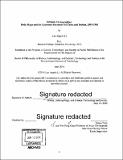| dc.contributor.advisor | Emma Teng. | en_US |
| dc.contributor.author | Li, Lan Angela | en_US |
| dc.contributor.other | Massachusetts Institute of Technology. Program in Science, Technology and Society. | en_US |
| dc.date.accessioned | 2016-09-30T19:35:46Z | |
| dc.date.available | 2016-09-30T19:35:46Z | |
| dc.date.copyright | 2016 | en_US |
| dc.date.issued | 2016 | en_US |
| dc.identifier.uri | http://hdl.handle.net/1721.1/104562 | |
| dc.description | Thesis: Ph. D. in History, Anthropology, and Science, Technology and Society (HASTS), Massachusetts Institute of Technology, Program in Science, Technology and Society, 2016. | en_US |
| dc.description | Cataloged from PDF version of thesis. | en_US |
| dc.description | Includes bibliographical references (pages 253-300). | en_US |
| dc.description.abstract | This dissertation explores how body maps served as a site for theoretical, experimental, and cultural entanglements between "Chinese medicine" and "biomedicine." It explores how body atlases produced under varying social and cultural conditions involved similar ontological questions with diverging social and cultural implications. These ontological questions set into motion disparate theories about the body that continue to destabilize contemporary medical practice. I explore the fate of maps that medical practitioners in China and Britain traced on paper and on people. Rather than representing what could be directly observed, these maps made visible what could be felt. Body maps offer a unique approach to transnational histories of science and medicine because they existed as meticulously crafted artifacts of visual perception and material evidence that carried social and political currency. In particular, I follow how Chinese physiologists re-presented meridian paths for acupuncture moxibustion practice and the conceptual friction that these maps introduced once they were compared with sensation maps that British neurologists produced to identify peripheral nerve clusters and distinct areas of pain. Amidst state-building efforts in the early twentieth century, medical practitioners in China reproduced meridian maps to emphasize the technical and systematic virtues of acupuncture moxibustion. Yet, meridian maps presented an ontological problem, as standardizing its paths required fixing locations along courses that shifted in living bodies. This dissertation picks up where political historians leave off, examining transformations in medical theory and tracking how individuals concerned with constructing the legacy of medicine in China eventually came to resurrect abandoned neurophysiological maps produced in late nineteenth century Britain. Through a careful excavation of image and text, I demonstrate how efforts to locate shifting areas on the surface of the body conflicted and cohered with discourses of science. I argue that "intimate cartographies," or maps based on individual encounters of the body, challenged standards of visualizing and describing unseen physiological systems. These maps sat at the intersection of epistemic practices, where the circulation of images, ideas, and individuals contributed to the complex convergence of body maps across regimes of knowledge. | en_US |
| dc.description.statementofresponsibility | by Lan Angela Li. | en_US |
| dc.format.extent | 300 pages | en_US |
| dc.language.iso | eng | en_US |
| dc.publisher | Massachusetts Institute of Technology | en_US |
| dc.rights | M.I.T. theses are protected by copyright. They may be viewed from this source for any purpose, but reproduction or distribution in any format is prohibited without written permission. See provided URL for inquiries about permission. | en_US |
| dc.rights.uri | http://dspace.mit.edu/handle/1721.1/7582 | en_US |
| dc.subject | Program in Science, Technology and Society. | en_US |
| dc.title | Intimate cartographies : body maps and the epistemic encounter in China and Britain, 1893-1985 | en_US |
| dc.title.alternative | Body maps and the epistemic encounter in China and Britain, 1893-1985 | en_US |
| dc.type | Thesis | en_US |
| dc.description.degree | Ph. D. in History, Anthropology, and Science, Technology and Society (HASTS) | en_US |
| dc.contributor.department | Massachusetts Institute of Technology. Program in Science, Technology and Society | |
| dc.identifier.oclc | 958655468 | en_US |
